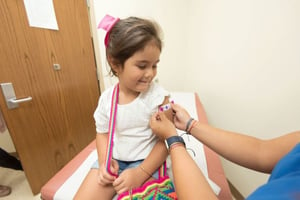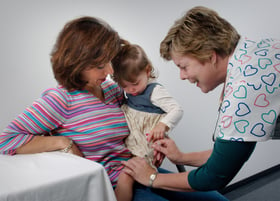Although many people think that pharmacists only fill prescriptions, independent pharmacy owners are playing a much bigger role in their communities.
More pharmacy owners are offering other health care services, transforming their pharmacy into a one-stop health care hub. One of the growing services that pharmacists are offering are vaccinations. This comes as no surprise since pharmacists are one of the most accessible healthcare providers. Offering vaccinations at a pharmacy not only improves vaccination rates among the community, but can help independent pharmacy owners generate additional revenue.
We are proud sponsors of the CEImpact Webinar -- “Reduce the Anxiety: Best Practice for Pediatric Immunizations.” We have captured key points from their webinar on successfully administering childhood vaccinations in the pharmacy.
Attitude is Everything
 Maybe you remember what it felt like to get your vaccines as a child. If you’re like most people, it was a pretty scary and stressful experience. Yet, your attitude can help influence a child’s experience.
Maybe you remember what it felt like to get your vaccines as a child. If you’re like most people, it was a pretty scary and stressful experience. Yet, your attitude can help influence a child’s experience.
Remaining positive and soothing can help an anxious child relax. It is also important to ensure that you answer questions honestly, because they will most likely remember anything you say the next time they come in to get vaccinated. If you promised they wouldn’t feel a thing, but they actually did feel some discomfort, the child will most likely learn to distrust vaccine administrators in the future.
Remember, attitude can change the experience for the better. Even holding a conversation with the child during the vaccination, can help distract them.
Positioning
Positioning a child during vaccinations is one of the most critical steps to achieving a successful visit. Young children often struggle to stay still due to their age or fear of receiving a vaccine. It is also important to ensure that the child is positioned in a secure manner that allows for the vaccine to be administered safely.
For infants and toddlers, parents should assist by holding the child in their lap and holding on to the child's arms to prevent them from flailing. The child's legs should be firmly secured between the parents thighs to minimize movement.
Older children should stand in front of the parent, and be embraced to prevent any large movements. The parents legs should also wrap around the child’s legs to avoid any kicking or thrashing while they are being administered the vaccine. It is important to help the child feel supported and comfortable during their vaccinations.
Improving Access to Vaccinations
The U.S. Department of Health and Human Services has approved pharmacists and pharmacy interns to administer vaccines for children ages 3 through 18 years of age, regardless of state regulations.
This is a great opportunity to improve childhood vaccination rates within your community, and help children stay on track. More parents are avoiding doctor’s offices for the fear of being around other sick patients, so increasing access to vaccines can help encourage parents to vaccinate their child
Want to learn how your pharmacy can offer pediatric immunizations? Watch the full webinar for more tips and information to help you get started.
If you'd like a free download to assess your pharmacy's readiness for doing immunizations, click here.



.png)



.png)

